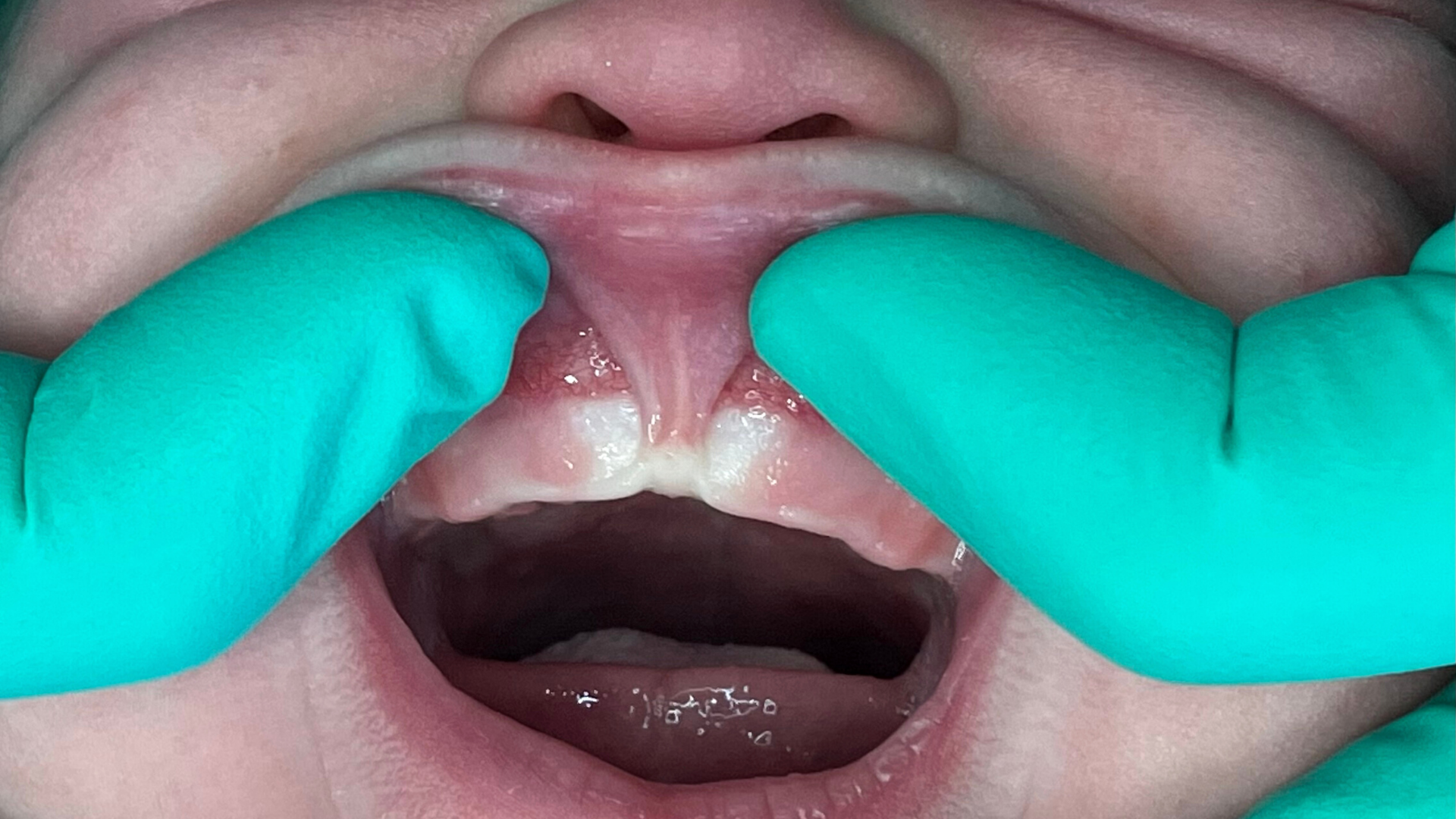What is Tongue Tie Surgery?
A frenectomy, also known as tongue tie surgery, is a medical procedure performed to address a condition known as ankyloglossia, where the strip of skin beneath the tongue (lingual frenulum) is shorter than usual, limiting the tongue's range of motion. This condition is commonly referred to as a "tongue tie." In some cases, a similar condition may affect the upper lip, known as a "lip tie."
An estimate of 4 to 11 percent of babies have tongue-tie*
Frenectomy is commonly recommended for infants experiencing feeding difficulties, speech issues, or other challenges due to the restricted movement of the tongue or lips. The procedure aims to enhance overall oral health and function by eliminating the limitations imposed by the tight or shortened frenulum.
Why Does my child need a frenulectomy?
Tethered oral tissues (TOTs) are a common problem among infants struggling to nurse or bottle feed. These oral tissues can inhibit the mouth functioning in the proper manner and prevent successful latching.
There are four classifications for the attachment and tightness of seven different frenums. All seven frenums are checked for form and function in the consultation with Dr. Bowen or Dr. Deacy. The frenums of concern will be classified from 1-4 to determine the necessity of a revision to aid in better latching/feeding. These tissues are removed with a laser during the procedure with a small amount of topical anesthetic.
Learn more about this surgery
here.

Symptoms commonly caused by TOTs: Signs your infant may need Tongue Tie Surgery
Baby’s Signs:
- Shallow latch at breast or bottle
- Falls asleep while eating, Slides or pops on and off the nipple
- Clicking sound while nursing
- Gassy or acid reflux
- Feeding feels like a full-time job (frequent feeding every 1-2hrs or more)
- Poor weight gain
- Milk dribbles out of the mouth while nursing or bottle feeding
Mom’s Signs:
- Pain during latching or nursing
- Flattened/lipstick shaped nipples after feeding
- Blistered/sore nipples requiring nipple shield
- Poor/ incomplete breast drainage
- Blocked ducts or mastitis, Engorgement
- Decreased milk production
Tongue Tie Surgery: What to Expect
Arrival and Consultation
When you arrive, you will be escorted to our private consultation room away from the rest of our patients. Our consultation evaluates the parents' concerns, child’s mouth anatomy and function, discussion of the procedure and post-operative instructions, and typical FAQs.
Parent(s) are then given financial information for procedure(s) and can decide to have the procedure done the same day or at a later date.
Most parents want to have the procedure completed the same day since they have already made the trip. This is something we build into our schedule and we feel best about not charging for the consultation, due to the large expenses that come from infant necessities.
Dr. Bowen
and
Dr. Deacy have received advanced training in treating tethered oral tissues in infants, children, and adults.


The Tongue Tie Procedure and Post-Op Evaluation
- The procedure begins with swaddling the infant in a SwaddleMe swaddle to ensure safety. The infant is carried to the treatment room. The parents are able to watch the procedure, if they wish, in the treatment room.
- Two assistants assist the procedure, one holding the infant and the other assisting the doctor. Anesthetic is placed on the areas to be treated. The frenum tissue is removed and checked for sufficient mobility and release.
- The infant is returned to the parent(s) to feed in our private consultation room. An armed chair and Boppy breastfeeding pillow are provided for comfort while feeding. The family is given privacy for 5-10 minutes to attempt feeding and provide comfort to the infant.
Your doctor then returns to evaluate how it went, if the parent(s) have any questions, and to review post operative instructions.
Dr. Bowen and Dr. Deacy have both experienced these procedures with their own children and will provide encouragement, tips that helped each of them and are happy to answer any questions the parents may have. Post operative instructions are printed and the exercises are individually reviewed for clarification.
The family is then clear to check out with our treatment coordinators and scheduled for a post-operative evaluation in 10-14 days.
What are the risks of a frenectomy?
Tongue tie correction is not a quick fix and successful breastfeeding/feeding is a process and journey that looks different for every baby. As any new parent knows, there isn’t a manual or instruction booklet for a new baby. Although this would make things much easier as you learn to take care of your child, every baby is different. No matter if it’s your first or fifth baby, every baby has a learning curve. This is also true with breastfeeding.
A recent
New York Time's article
has stirred questions about the legitimacy of the tongue-tie surgery. We at Dental Arts believe that like any healthcare journey, certain procedures may not be the best fit for every individual.
We see parents who are on their third and more children where they never had issues with breastfeeding and now this new baby is truly struggling. Take this as an encouragement that even if one child has tie(s) it doesn’t destine your next child(ren) to also have issues. With every aspect of the human body, there are multiple factors that aid or inhibit proper function. The idea that a tie correction can magically overnight fix a feeding issue couldn’t be further from the truth. A team of healthcare professionals working in collaboration is vital for a successful breastfeeding journey if issues present. A certified lactation consultant (IBCLC), myofacial specialist, chiropractor, and occupational or physical therapist can all provide invaluable expertise in the before and after care of a baby with feeding complications. As with any new skill, successful breastfeeding and feeding take time, patience, and commitment from both baby and parents.
Not all babies with feeding issues have ties.
If ties are present, feeding can be compromised for a number of reasons. This is why an evaluation by a doctor who is qualified and certified to diagnose the severity of ties is vital before any correction takes place. All babies are different and the lack of ability to latch can be caused by weakness of muscles, the fact that they are learning a new skill, and by restriction of movement by the tongue, lip, and muscles in the mouth and jaw. Difficulties with feeding can also be a true anatomical malformation that would need to be addressed by a surgeon. To categorize all infants who struggle to successfully latch and feed into one category is not only inaccurate, but harmful.
It is always up to the parent if they want to have the procedure completed.
Parents of infants always have the autonomy to decide what is best for their child. Even if the baby is diagnosed with a severe tongue, lip, or cheek tie, the parents always have the right to decide to do nothing. Parents ask us how necessary the procedure is and this is not a cookie cutter answer. Depending on how severe the tie(s) present determines how impactful the surgery will be in aiding in better feeding. This is always discussed with the parents as every baby will recover from the procedure in their own way and time.
*https://www.nytimes.com/2023/12/18/health/tongue-tie-research-breastfeeding.html